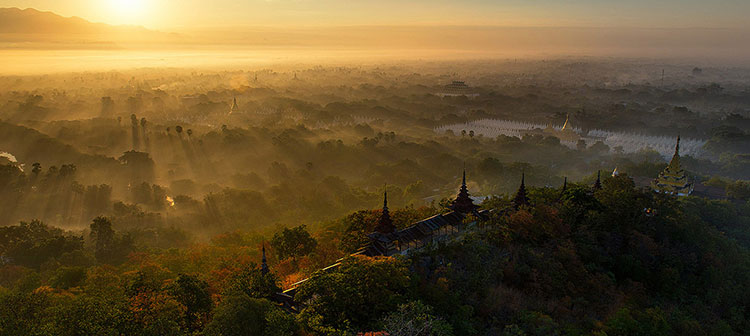
The capital of Myanmar Last Kingdom and of Myanmar Kings, is situated in Central Myanmar 668 km north of Yangon. It was founded by King Mindon in 1857 and remained to be the official seat of Myanmar Kings until it was occupied by the British in 1885 and designated Yangon as capital. It is the largest city after Yangon and is both a bustling commercial center and a repository of rich cultural heritage. With the remains of the old Royal City and many old monasteries, Mandalay is a showcase for Myanmar art and architecture of the 19th century. It is also noted for woodcarvings, silverware, tapestries, silk, and other products of traditional handicraft. It has links to all parts of the country by rail, road, river and air.
How to get there:
It takes about 1 ½ hours by air from Yangon. There are daily fights from Yangon, Bagan and Heho to Mandalay. The new Mandalay International Airport has been opened and operated since November 2000, with direct flights of some regional airlines. Express trains are running from Yangon to Mandalay, which take about 14 hours. Private express coaches also run everyday along Yangon-Mandalay highway, which is over 700 km long. If you travel overland you can also break the journey at Taungoo (280 km) or at Meiktila (540 km), where there are hotels for overnight stay.
What to see:
Downtown:
Mandalay itself is a dirty, dusty town with some areas that have changed little in nearly a century, but it oozes with photographic opportunities and has its own special charm. Take a walk along the riverside early morning or late afternoon to watch the busy riverside activity and to see the water buffalo working hard to bring newly felled logs to the shore or spend a couple of hours wandering around the sprawling Zegyo Market, originally designed by an Italian architect in 1903. The Zegyo Market is the center of trade linking between towns of upper and lower Myanmar. Various local and imported (mainly from China and Thailand) goods are in business. The Italian-styled old market building was demolished and replaced with modern form. The Clock Tower, next to the Zegyo Market, was built in 1903 to commemorate the diamond jubilee of Queen Victoria,
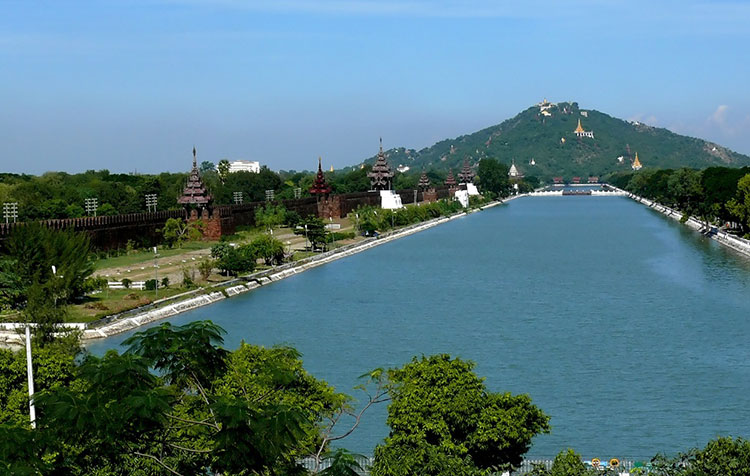
Mandalay Hill:
The natural landmark of Mandalay, a vantage-point for panoramic view of the city. The stairways have been constructed from the bottom to top of the hill which you can climb at ease and rest as you go up the stairway. There is a saying that if you want to live long, you take refuge in the environs of Mandalay hill. It means that as climbing to the Mandalay hill on foot is good for health. And to pay homage to the pagoda along the way makes one live long.
You can pay homage to prominent pagodas along the stairway of Mandalay Hill. Besides, you can visit the shops of Myanmar traditional handmade toys, gifts such as beads.
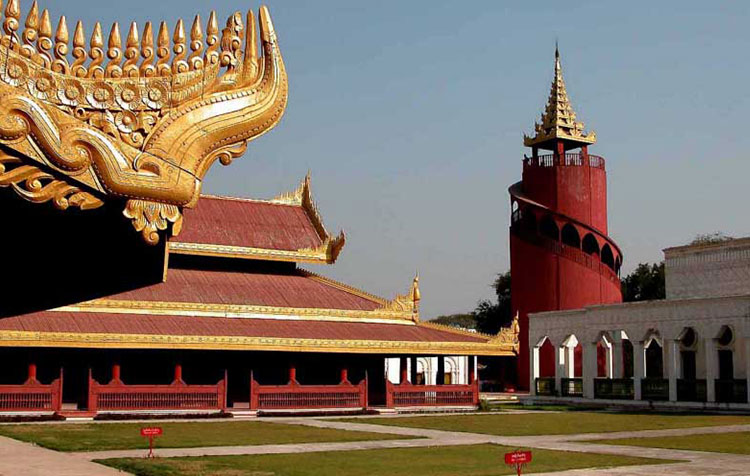
Mandalay Palace:
The whole magnificent palace complex was destroyed by fire during the World War II. However, the finely built palace walls, the city gates with their crowning wooden pavilions and the surrounding moat still present an impressive scene of the Mandalay Palace. A number of palace buildings namely "Mya-nan-san-kyaw Shwenandaw", the model of the Mandalay Palace, Nanmyint-saung have been rebuilt and the Cultural Museum is also located inside the palace grounds.
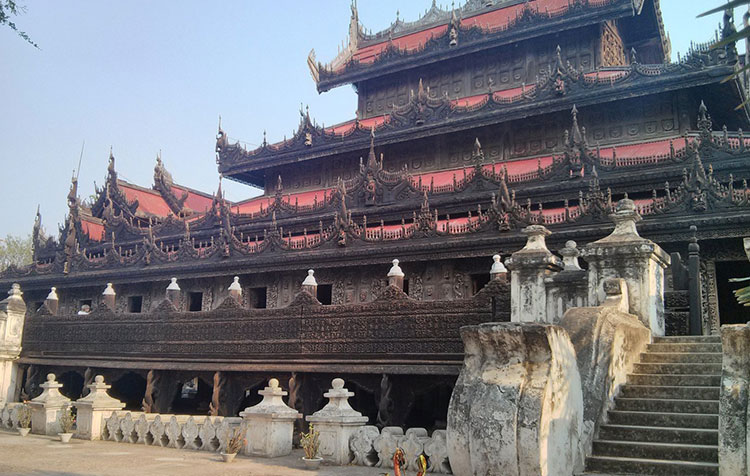
Shwenandaw Monastery:
Famous for its intricate wood-carvings, this monastery is a fragile reminder of the old Mandalay Palace. It was originally built inside the Mandalay Palace but it was moved to the present site by King Thibaw in 1880.
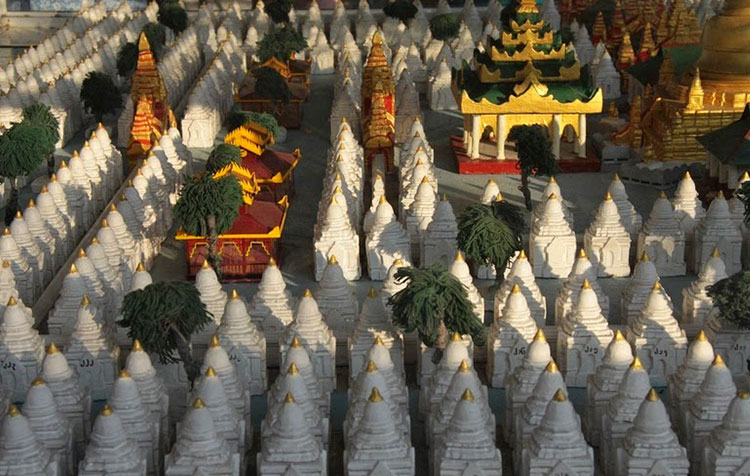
Kuthodaw Pagode:
Im Jahre 1857 von König Mindon nach der Vorlage der Shwe Zigon Pagode in Nyaung U erbaut, ist diese Pagode von 729 aufrechten Steintafeln umgeben, auf denen die gesamten, von der 5. buddhistischen Synode redigierten und genehmigten Schriften aufgezeichnet sind. Wegen dieser Steinschriften ist sie volkstümlich als "das größte Buch der Welt" bekannt.
Atumashi Kyaung:
The Atumashi Kyaung, or Incomparable Monastery was originally built in 1857 by King Mindon (1853-1879) and burned down in 1890. For many years the ruins of the building lay open to the elements. Stumps of the charred teak
pillars, a grand staircase and some colonnaded walls remained. The area was cleared in the 1990s and was rebuilt according to the original plans in 1996 by the Burmese archaeological department with the use of convict labor. While somewhat impressive, it does not come close to recreating the magnificence of the original building. The Atumashi Kyaung is near the Kuthodaw Pagoda, built at the same time, and next door to the Shwenandaw.
Kyauktawgyi Pagoda:
Near the southern approach to Mandalay Hill stands the Kyauktawgyi Pagoda of the Buddha Image that was built by King Mindon in 1865. The Image was carved out of a huge single block of marble and sculpted. It was hauled to its position by nearly 12,000 men and took 13 days to transport the marble. The statues of 80 Arahants (the Great Disciples of the Buddha) are around the Image, 20 on each direction.
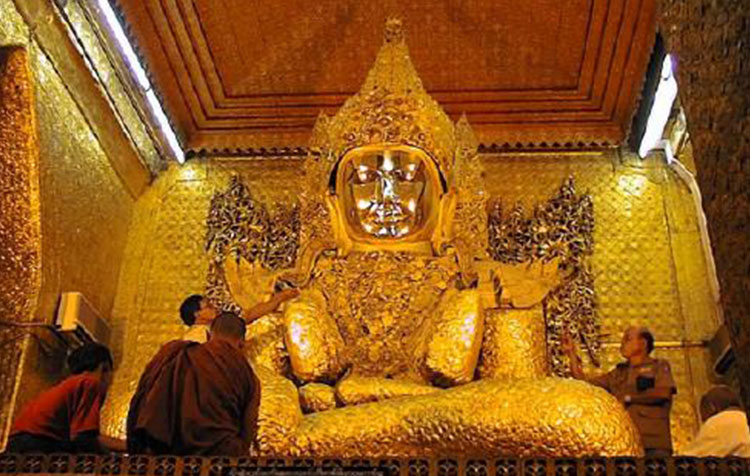
Maha Muni Pagoda
Maha Muni Pagoda: Revered as the holiest pagoda in Mandalay, this pagoda enshrines the famous Maha Muni Buddha image, which is said to have been cast in the life-time of and in the very presence of the Buddha. Consequently, devout Buddhists hold it to be alive and refer to it as the Maha Muni Sacred Living Image. The Image in sitting posture is 12 feet and 7 inches (3.8 meters) high. It was brought to Mandalay from Rakhine State during the reign of King Bodawpaya in 1784. The early morning ritual of washing the Face of the Buddha Image draws a large crowd of devotees everyday. And the image is also considered as the greatest, next to Shwedagon Pagoda, in Myanmar. A visit to
Mandalay would be incomplete without a visit to Maha Muni Pagoda.
Shwe In Bin Monastery:
This attractive monastery built in traditional Burmese fashion is one of the few buildings that have survived the test of time. Constructed in 1895 by Chinese merchants, the monastery consists of many impressive woodcarvings and also contains a number of admirable works of art. At present there are 35 monks that live in the monastery complex which is held up by the classical teak foundation that is often seen throughout the country but rarely in as good condition as at this illuminating site.
Yankin Hill:
3 km east of Mandalay Fort has a whole complex of temples and monasteries running along the top of its ridge. With two staircases at either 'end' of the hill, you can walk the complete circuit - so take your shoes with you.
Arts and Crafts
For lovers of arts and crafts, Mandalay represents the largest repository of Myanmar arts and crafts. It is here that visitors can observe skilled craftsmen making beautiful articles of tapestry, ivory, wood, marble and stone carving and engravings, silverware and bronze statues according to the time-honored traditions of their forefathers. Besides those, the other arts and crafts workshops of silk-weaving and gold-leaf making are also places worthy of visiting.
Mingun:
Located about 11 km upriver from Mandalay, on the west bank of the Ayeyawaddy River. The one hour boat trip to Mingun is a very pleasant way to see the real life on the river. Mingun has a gigantic unfinished pagoda, 50 meters high, overlooking the river, and the 90-ton Mingun Bell, the largest ringing bell in the world cast in 1170 by King Bodawpaya.
Hsinbyume Pagoda
Amarapura: Amarapura the "City of Immortals", situated about 11 km south of Mandalay, was the capital of upper Burma until 1850. As it was the custom, most of the important wooden palaces and monasteries were taken down and transported to the new capital in Mandalay. Little remains of the old Amarapura palace but you can still find two masonry buildings - the treasury building and the old watchtower. The corner pagodas still stand at the four corners of the once square city. Apart from Pagodas that have survived, the ancient art of silk and cotton weaving, using handlooms is very much alive. The 150 year old Mahagandayon Monastery, is a famous Buddhist learning center and home to a thousand monks, who will form a procession as they go to take their noon and final meal of the day and the 1.200 meter long U Bein wooden bridge, over 150 years old, is the longest teak bridge in the world.
In-wa (Ava):
Ava situated on a small island, between the Ayeyarwaddy and Myittha rivers, was first founded as a capital by King Thado Minbya in 1364 A.D. It was destroyed by the earthquake of 1838. The ruins of the palace, the massive fort walls and moat can still be seen of the splendour of the past when it had been the capital for more than four and half centuries. The best way to explore this island is by horse cart. The king palace at that time does not exist any longer, however still the “Leaning Tower” of Inwa, 27 meter (90 feet) high masonry Watch Tower. The Maha Aung Mye Bon Zan Monastery, a brick-and-stucco monastery built by the Chief Queen of King Bagyidaw for her royal abbot (Nyaung Gan Sayadaw) in 1818 and the Bagayar Monastery, famous for its impressive ornate woodcarvings and teak posts are the high lights.
Sagaing:
Sagaing lies 21 km southwest of Mandalay on the opposite bank of the Ayeyarwaddy River. Once you cross the Inwa Bridge, you see the hilltops, each crested with a pagoda, the banners proclaiming the Buddha's teaching, the refuge from all ills and tribulations where over 600 monasteries for monks and nuns are located for Buddhist studies and meditation. The Padamyazedi dates from 1300 while the U min Thonze or thirty caves pagoda has many Buddha images in a crescent shaped colonnade. Mural paintings can be seen in the Tilawkaguru cave temple, which was built around 1672. At the nearby village of Ywahtaung you can see silver workers producing bowls and other silver items by traditional methods. The most impressive Soon Oo Pon Nya Shin Pagoda nearby was constructed in 1312. The view of Sagaing from Soon Oo Pon Nya Shin and its approach is marvelous. About 10 km from Sagaing is the Kaunghmudaw, an enormous dome-shaped pagoda built by King Thalun in 1636, on the model of the Mahaceti Pagoda of Sri Lanka. At the nearby village of Ywataung, you can see silversmiths making silverware by traditional methods.
Monywa & Pho Win Daung:
About 136 km to the west of Mandalay lies Monywa, the commercial center of the Chindwin Valley or northwestern Myanmar. Places of interest include Thanbokde Pagoda, with over 500,000 Buddha images; Bodhi-ta-taung (one thousand Bo trees): Ledi Kyaungtaik, a teaching monastery where Buddhist scriptures are inscribed on 806 stone slabs: and Kyaukka Village, known for its own distinctive style of lacquerware. Just on the other side of the Chindwin River and a 30 minutes drive by pick-up is the seldom visited 15th Phowin Taung temple complex where more than 450,000 sandstone Buddha’s were carved in the hillsides in caves, alcoves, or tiny niches. The cave murals are still intact with indigo blues and soft pastels. Many of the Buddha’s can be seen without entering the caves or niches and footwear is permitted as long as one is not entering the sanctuaries. A stunning Buddha not to be missed is
the reclining Buddha resting on a rectangular stone mosaic which shimmers with cut glass."
Shwebo:
Shwebo is a rice-collecting centre on the railway about 50 miles (80 km) north-northwest of Mandalay and 17 miles west of Kyauk Myaung, a river-side town on the Ayeyarwady, which is famous for glazed pottery works from toys, cups, letters, bowls, pots to huge water jars that are tied in hundreds and floated down the river as rafts. These are widely used throughout the country. Shwebo was the birthplace of Alaungpaya, founder of the Alaungpaya dynasty (1752–1885), and is the site of his tomb. The palace and other royal parks, lakes, moats and watch tower have been neglected, disrepaired, ravaged and ruined in the last two centuries. With the promotion of the tourism industry, the government has launched upon the reconstruction of the palace buildings, parks and dredged the royal lake for the benefit of the visitors and locals.
Pyin-Oo-Lwin (Maymyo):
Over 1000 meters above sea-level, Pyin Oo Lwin is a popular hill station about 69km away from Mandalay. It is well known for its colonial style houses with large compound and pine trees, eucalyptus and silver-oak abound in town. Delightfully cool and pleasant the whole year round. It was founded by Myanmar official Maung Dwe in 1851 and later named as May Myo by British Colonel May in 1896. The 142-hecter well laid-out Botanical Garden, scenic Pwe-kauk Waterfalls, Chinese Temple in addition to British built colonial buildings are places worth visiting. Nearby are Peik-chin-hmyaung Cave and Gokteik Rail Bridge.
Paleik:
You can find many wondrous places in various part of the world and Myanmar is no exception. One of these is the Snake Pagoda, situated at the town of Paleik, which is 15 miles from Mandalay. The formal name of the Pagoda is known as “Ratana Laba Muni Sutaungpyi Muei Phaya” but it is known to be as “Meui Phaya” or “Snake Pagoda”. In 1977, a Buddhist monk was clearing the bush in that area and found a Buddha image inside a ruined Pagoda.
On top of the image were three large pythons and from that time on, the place became known far and wide in the country as the Snake Pagoda. Each snake is fed a pot of milk and three eggs every five days. But later on, due to instructions from a veterinarian, each was given 50 ticals of goat meat for protein. But every morning at 11:00 a.m., the snakes are given a bath. Pilgrims from various parts of the country come to pay homage to the snake Pagoda in Paleik town whenever they arrive in Mandalay. It is Buddhist belief that even animals through merit earned in previous existences are deserving of care and attention.
Mogok:
Mogok, known as Gems city, lies in a beautiful mountain valley 128 miles to the north-east of Mandalay, and 60 miles to the east of Ayeyarwady river. Myanmar rubies, sapphires and emeralds and other precious stones are mined in Mogok area. Only packaged tours are allowed to visit Mogok with special permission.







